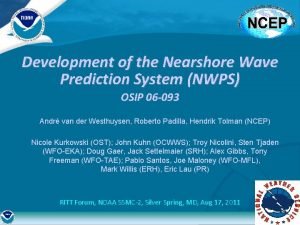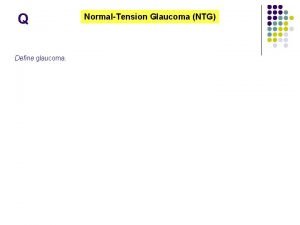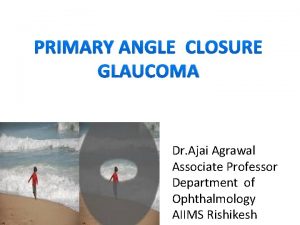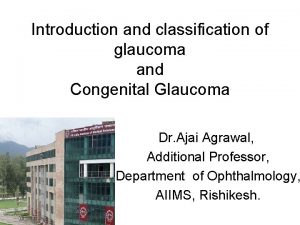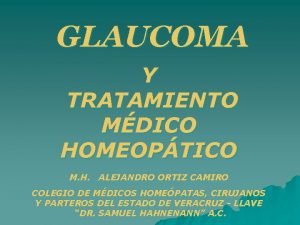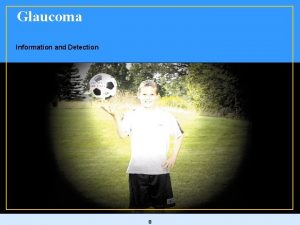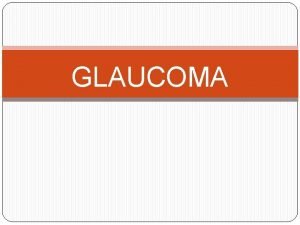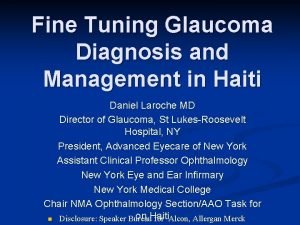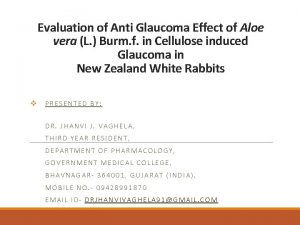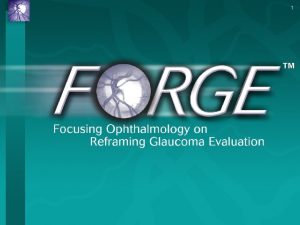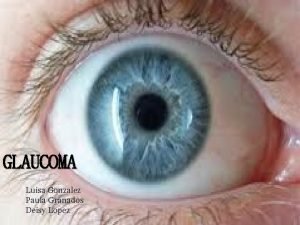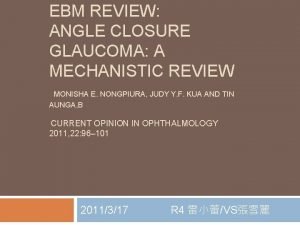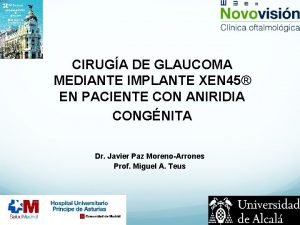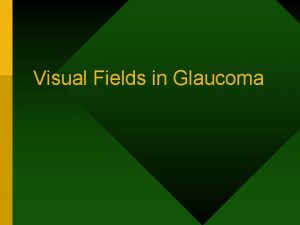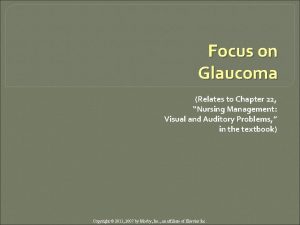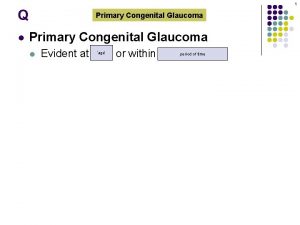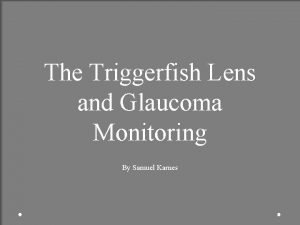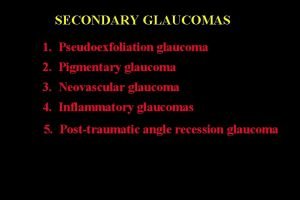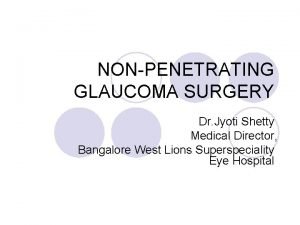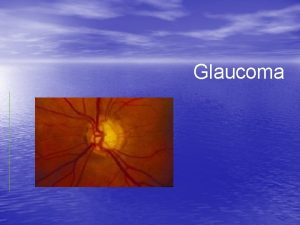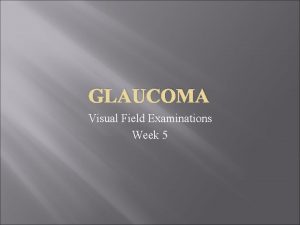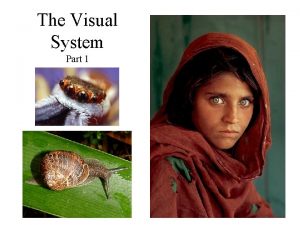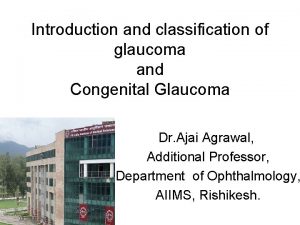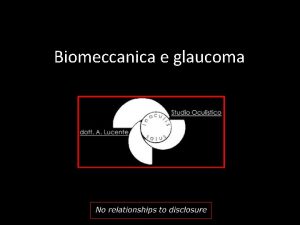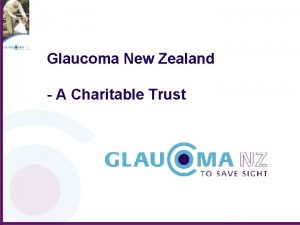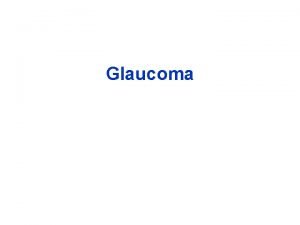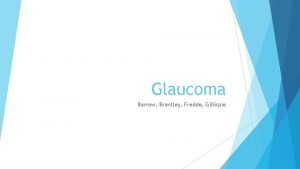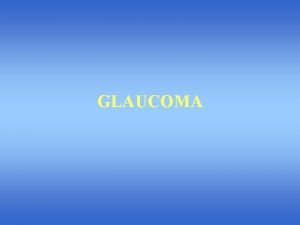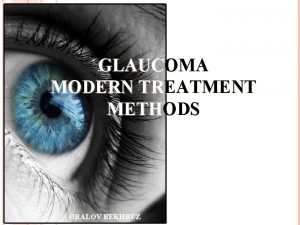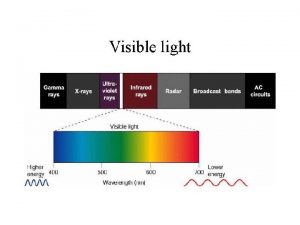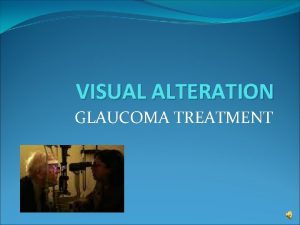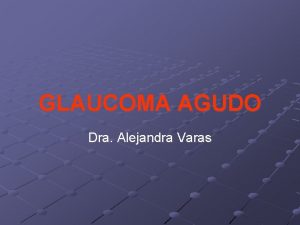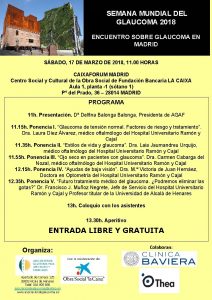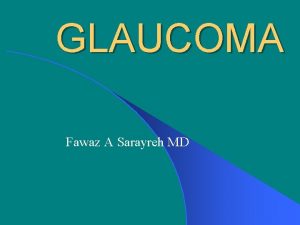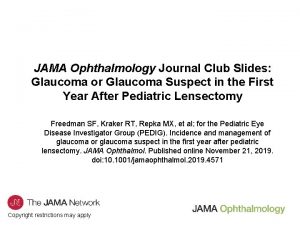NeuroFuzzy Glaucoma Diagnosis and Prediction System Investigator Dr






























- Slides: 30

Neuro-Fuzzy Glaucoma Diagnosis and Prediction System Investigator Dr. Mihaela Ulieru, Faculty of Engineering, The University of Calgary Co. Investigator Dr. Andrew Crichton, Faculty of Medicine, The University of Calgary Research team Dr. Nicolae Varachiu, Cynthia Karanicolas, Mihail Nistor, Faculty of Engineering, The University of Calgary

Presented papers based in this project Title Authors IASTED International Conference, Banff, July 2002 Integrated Soft Computing Methodology for Diagnosis and Prediction with Application to Glaucoma Risk Evaluation. Mihaela Ulieru, Faculty of Engineering, The University of Calgary Gerhardt Pogrzeba, President and CEO, TRANSFERTECH Gmb. H, Braunschweig, Germany First IEEE International Conference in Cognitive Infromtatics. ICCI’ 02, Calgary, August 2002. Computational Intelligence for Medical Knowledge Acquisition with Application to Glaucoma. Nicolae Varachiu, Cynthia Karanicolas, Mihaela Ulieru, Faculty of Engineering, The University of Calgary

Introduction Diagnosis: to determine if a patient suffers of a specific disease; if so, to provide a specific treatment Glaucoma: a progressive eye disease that if left untreated, can lead to blindness The main challenge for glaucoma specialists is the evaluation of the risk for its occurrence and the prediction of disease progression to establish a suitable follow up and treatment accordingly

Most cases in glaucoma diagnosis are quite evident, but at least 5% of them will be ambiguous For these special cases the assessment of an “expert machine” can be essential in determining the right time for a follow up check as well as in-between treatment In response to this need we have developed an integrated diagnosis and prediction methodology that uses several soft computing techniques

5 Glaucoma Cupping of the Optic nerve head Visual field Loss Elevated Intraocular Pressure

6 Loss of visual field Clear image of a road. Note runner with white shirt on the left. Glaucoma Visual Field Loss LEFT EYE Arc shaped loss of sensitivity starting from the normal blind spot (near where the runner is) into the inside (nasal) field of vision Glaucoma - severe visual field loss. Only a small central island of vision remains. The centre of the vision is cut through horizontally as well

7 Intraocular Pressure The inner eye pressure (also called intraocular pressure or IOP) rises because the correct amount of fluid can’t drain out of the eye

8 Optic disc nerve damage

9 Glaucoma can also occur as a result of: An eye injury Inflammation Tumor Advanced cases of cataract Advanced cases of diabetes Also by certain drugs (such as steroids)

10 Treatments Medications Laser surgery Filtering surgery

11 Knowledge representation Knowledge repository Fuzzifier Inputs Fuzzy logic Inference System (Processing model) Defuzzifier Outputs

12 <x, T(x), U, G, M> Linguistic variables x = the Intraocular Pressure (IOP) T(IOP) = {Low, Normal, High} U = [0, 45] (measured in mm of Hg) Low might be interpreted as “a pressure above 0 mm Hg and around 11 mm Hg”; Normal as “a pressure around 16. 5 mm Hg” and High as “a pressure around 21 mm Hg and bellow 45 mm Hg”.

13 Membership Function 1 Low 0 0 Normal High 12 16. 5 22 45 mm Hg Fuzzy sets (linguistic terms: Low, Normal, High) to characterize the linguistic variable Intraocular Pressure - IOP

14 Knowledge Acquisition Iterative process that involves domain expert(s), knowledge engineers and the computer

15 Knowledge acquisition steps developing an understanding of the application domain determination of knowledge representation selection, preparation and transformation of data and prior knowledge extraction (machine learning) model evaluation and refinement

Design of the knowledge engine for disease assessment The diagnosis of Glaucoma comprises the analysis of a myriad of risk factors, each of them related to the diagnosis with different degrees. The rule base is being developed following an incremental development process Existing data, Requirements, goals Visits to dr. ’s office Ophthalmologist feedback Visits to dr. ’s office Ophthalmologist’s feedback Neuro – fuzzy System Complete set of fuzzy rules Top-level specifications Incremental development plan Iteration 1: First set of rules Iteration 2: Second set of rules Iteration n

17 Main steps of the process Gather and select relevant information to create or modify the set of rules Create, add or modify linguistic variables and/or fuzzy rules Ophthalmologist’s feedback Rule set evaluation and refinement

In the first increment a minimal group of Fuzzy IF-THEN rules has been created. This ‘basic’ set of rules is the foundation for selecting relevant learning data for improving the prediction engine. Different risk factors and data is being used to add new rules in each successive increment. Each increment will contain all previously developed rules plus some new ones determined to be relevant by the medical expert.

19 Fuzzy linguistic variables U M Measure ment unit x T (x) 1 Visual field tests Low damage Damage Severe damage [0, 76] 2 Visual acuity Normal Abnormal [20/15 20/400] 3 Myopia High [-10, 4] A 3 = {-10/1 -4/1 0/0 4/0} No. 4 Cup to disc High ratio [0 1] A 4 = {0/0 1/1} Number N° A 1 LD = {0/1 15/1 30/0 76/0} A 1 D = {0/0 15/0 30/1 45/1 60/0 76/0} A 1 SD = {0/0 45/0 60/1 76/1} A 2 N = {20/15/1 20/20/1 20/50/0 20/400/0} A 2 A = {20/15/0 20/20/0 20/50/1 20/400/1} Low points Number

20 Fuzzy linguistic variables N° x T (x) U M Measure ment unit [0, 45] A 5 H = {0/0 16. 5/0 22/1 45/1} A 5 M = {11/0 16. 5/1 22/0} A 5 L = {0/1 11/1 16. 5/0 45/0} Mm. Hg 5 IOP High Normal Low 6 Diurnal Fluctuati ons of IOP Low High [0, 10] A 6 L = {0/1 5/0 10/0} A 6 H = {0/0 3/1 10/1} Mm. Hg 7 Age Old [0, 100] A 7 = {0/0 40/0 80/1 100/1} Years old Output OL = {0/1 33/1 50/0 100/0} OM = {0/0 33/0 50/1 66/0 100/0} OH = {0/0 50/0 66/1 100/1} 8 Risk Low Moderate High

21 Output interpretation Low risk: follow-up within 6 -12 months Moderate risk: follow-up within next 2 -6 months High risk: follow-up within next few weeks

22 If- Then Rules

23 Example Visual field tests Visual acuity Myopia Cup to disc IOP Diurnal Fluctuations of IOP Age FCM Result Doctor’s action 45 20/150 -9. 75 0. 8 15 0 80 51. 765: next 3 -4 months Appt within 3 -4 months

The diagnostic methodology at a glance Ulieru and Pogrzeba The methodology has been designed around the software suite developed by Transfertech Gmb. H Germany, by integrating several of their packages. Aim: emulate the assessment done by the expert physician and collect relevant data for predicting the disease progression Diagnosis Engine: embeds expert knowledge Prediction Engine: developed in a three-step process

Diagnosis Machine Parameters (Measured) Diagnosis Engine Disease Assessment Prediction Engine Prediction Treatment Doctor’s Decision Follow-up Time Doctor’s Decision Data Base Machine Parameters Disease Assessment Treatment Time Prediction

An evolutionary learning strategy for tuning the prediction engine This step assumes a database with sufficient patient information is already available The design of the database was a challenging process Input handwritten patient files. Database contains: measured parameters, disease assessment, treatment and time interval decided by medical expert and the result of the prediction engine.


Web-centric extension of the system Enable data from several clinics to contribute to the knowledge refinement process. The prediction system and the central database will be placed on a central server Database will be updated periodically A copy of the diagnosis and prediction engines will function in each clinic and will be updated after the learning process is done on the central ‘master’ copy Secure and reliable connection between local engines to the ‘master’ engine

Currently, we are working in the development of a holachy, that would enable the access of the diagnosis and prediction system from clinics and by nomadic patients

Conclusions Our goal is to make this system available on the international health care arena, therefore several standards have to be investigated and reconciled (e-health). The computational intelligence methods increase the accuracy and consistency of diagnosing, risk evaluation and prognostic of glaucoma Computational intelligence can embed in a natural way the uncertainty surrounding the complex medical processes, and in our specific situation can increase the accuracy and consistency of diagnosing, risk evaluation and prognostic of glaucoma
 Assessment in nursing process
Assessment in nursing process Medical diagnosis and nursing diagnosis difference
Medical diagnosis and nursing diagnosis difference Types of nursing diagnosis
Types of nursing diagnosis Types of nursing diagnoses
Types of nursing diagnoses Perbedaan diagnosis gizi dan diagnosis medis
Perbedaan diagnosis gizi dan diagnosis medis Child and family investigator colorado
Child and family investigator colorado Nearshore wave prediction system
Nearshore wave prediction system Iris nodules uveitis
Iris nodules uveitis Triggerfish glaucoma
Triggerfish glaucoma Glaucoma
Glaucoma Treatment for open angle glaucoma
Treatment for open angle glaucoma Schwalbe line
Schwalbe line Stumped cornea
Stumped cornea Homeoptico
Homeoptico Open angle glaucoma risk factors
Open angle glaucoma risk factors Acute glucoma
Acute glucoma Bayoneting vessels glaucoma
Bayoneting vessels glaucoma Indentation gonioscopy
Indentation gonioscopy Is aloe vera good for glaucoma
Is aloe vera good for glaucoma Isnt rule
Isnt rule Anillo neurorretiniano
Anillo neurorretiniano Primary angle closure glaucoma
Primary angle closure glaucoma Piomes
Piomes Hill of vision perimetry
Hill of vision perimetry Capsular glaucoma with pseudoexfoliation of lens
Capsular glaucoma with pseudoexfoliation of lens Pre and post operative nursing care of cataract
Pre and post operative nursing care of cataract Glaucoma nursing management
Glaucoma nursing management Haab's striae
Haab's striae Triggerfish glaucoma
Triggerfish glaucoma Pseudoexfoliation glaucoma
Pseudoexfoliation glaucoma Fornix based conjunctival flap
Fornix based conjunctival flap






